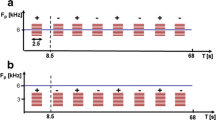Summary
The transient increase in admittance seen at the beginning of the acoustic reflex response in man was investigated with a view to reaching a better understanding of its possible mechanisms. The sound stimulus intensity, its duration and its off-time were varied to investigate their effects on the morphology of the admittance waveform. The results found suggest that the transient increase may not be due to a temporary partial decoupling of the ossicular chain during the initial stages of stapedial contraction, but rather that it may be caused by a slight improvement in the coupling between the middle ear components.
Similar content being viewed by others
References
Borg E, Odman B (1979) Decay and recovery of the acoustic stapedius reflex in humans. Acta Otolaryngol (Stockh) 79: 325–333
Clemis JD, Sarno CN (1980) The acoustic reflex latency test: clinical application. Laryngoscope 90:601–611
Feldman A, Zwislocki J (1965) Effect of the acoustic reflex on the impedance at the ear drum. J Speech Hear Res 8: 213–222
Freeman S, Zaaroura S, Sohmer H (1988) Concomitant changes in the acoustic impedance and the cochlear microphonic potentials during twitch contractions of the middle ear muscles in cats. Arch Otorhinolaryngol 245:311–315
Gelfand SA, Silman S, Silverman CA (1981) Temporal summation in acoustic reflex growth functions. Acta Otolaryngol (Stockh) 91: 177–182
Mangham CA, Burnett PA, Lindeman RC (1982) Standardization of acoustic reflex latency — a study in humans and nonhuman primates. Ann Otol 91: 169–174
Mangham CA, Burnett PA, Lindeman RC (1983) Evaluation of tensor tympani muscle dominance in the biphasic acoustic reflex. Audiology 22:105–119
Moller A(1965) An experimental study of the acoustic impedance of the middle ear and its transmission properties. Acta Otolaryngol (Stockh) 60:129–149
Niswander PS, Ruth RA (1979) A discussion of some temporal characteristics of electroacoustic impedance bridges. J Am Audiol Soc 5:151–155
Noether GE (1976) Introduction to statistics: a non-parametric approach, 2nd edn. Houghton Mifflin, Boston, pp 136–138
Price GR (1963) Middle ear muscle activity in rabbits. II. The gain threshold. J And Res 3:233–240
Ruth RA, Niswander PS (1976) Acoustic reflex latency as a function of frequency and intensity of eliciting stimulus. J Am Audiol Soc 2:54–60
Wever EG, Vernon JA (1956) The control of sound transmission by the middle ear muscles. Ann Otol 65: 5–14
Wilson RH (1979) Factors influencing the acoustic — immittance characteristics of the acoustic reflex. J Speech Hear Res 22:480–499
Author information
Authors and Affiliations
Additional information
Offprint requests to: S. Freeman
Rights and permissions
About this article
Cite this article
Freeman, S., Sohmer, H. The influence of sound stimulus parameters on the acoustic reflex waveform. Eur Arch Otorhinolaryngol 247, 104–108 (1990). https://doi.org/10.1007/BF00183178
Received:
Accepted:
Issue Date:
DOI: https://doi.org/10.1007/BF00183178




